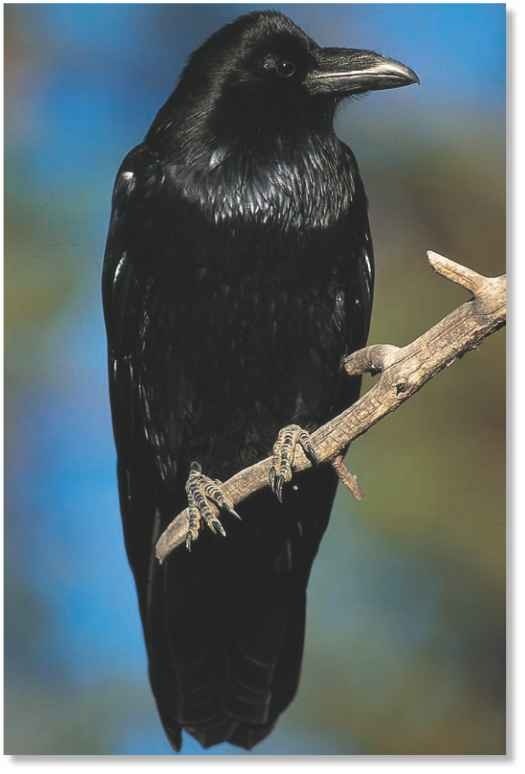ORDER
Passeriformes
FAMILY
Corvidae
GENUS & SPECIES
KEY FEATURES
• The world’s largest I perching bird
• Eats carrion as well as small animals it is able to kill
• Superbly skilled
in the air, performing simply dramatic aerobatic displays
• Adapts to a vast range of climates and habitats, from ice-cold Arctic lands and Himalayan peaks to searingly hot deserts
WHERE IN THE WORLD?
Across the Northern Hemisphere, from the Arctic (Alaska, northern Canada, Greenland, the far north of Scandinavia and eastern Siberia), south to the tropics (Honduras, Guatemala and Mexico)
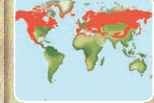
Lifecycle
As if delighting in their mastery of the skies, groups of ravens often indulge in breathtaking aerobatics, swooping, rolling and tumbling through the air, seemingly just for fun.
HABITAT
The raven lives across vast swaths of the Northern Hemisphere, from the Arctic — where it’s one of only a handful of birds to stay through the winter — as far south as tropical Central America. Very adaptable, it’s at home in temperate grasslands, tundra, coniferous and deciduous forests, low-intensity farmland, mountains, steppes and deserts. It also inhabits coasts and oceanic islands. It can cope with almost any climate, from the blistering heat of Death Valley, California (air temperatures are among the highest on Earth), to the cold summits ofTibetan mountains.
On top of the world Ravens are often found in wild, mountain country.
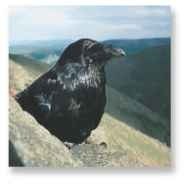
FOOD & FEEDING
Greedily seizing any meal, the raven feeds on almost every type of carrion it can find.The bulk of its diet are mammal carcasses, from rabbits and hares to deer and elk even stranded whales; livestock, especially sheep, are particularly important. During the winter in the U.S., deer that have starved to death or have been injured trying to cross the ice of frozen lakes provide a significant meal for raven in the area. Ravens also feed upon animals killed on roadways or left by predators.
If carrion is scarce, the raven can kill a range of small mammals and birds, targeting sick, wounded or young individuals and stabbing them to death with its bill. Whenever it can, it steals birds’ eggs, hunts crabs, reptiles, mollusks, earthworms and slugs if available, and even feeds on bones and seeds.
The raven plays a major part in legends and folklore of several peoples. The Anglo-Saxons thought King Arthur turned into one when he died; the Vikings regarded it as sacred.
Ravens usually steer clear of the eyrie (nest) of the golden eagle: one of their few natural predators. Young ravens are most at risk to this hunter.
A large, central Asian subspecies of raven was recorded at an altitude of 21,120′ on Mt. Everest.
BREEDING
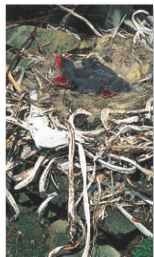
A Stick together A resourceful but untidy nest-builder, the raven uses any material that it’s able to carry.
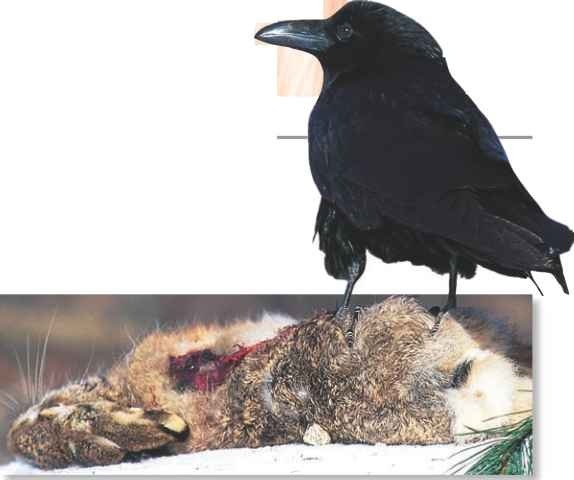
Cleaning up A raven gorging itself on the carcass of a hare. What it can’t eat at one sitting, it may bury to eat later.
Each pair of ravens builds a nest on an inaccessible cliff ledge or at the top of a tall tree. Early breeders, they lay their eggs in February to take advantage of losses of young farm animals as well as the deaths of newborn deer and wild sheep.
The female alone incubates the clutch of 4—6 eggs for about three weeks, relying on her mate to provide her with food. But the demanding task of feeding the offspring calls for a dual effort and lasts for 5-7 weeks, when the young finally leave the nest (right). If they haven’t moved on by autumn, their parents chase them away from their territory.
BLACK MAGIC
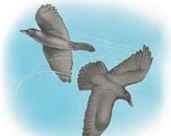
Fly-past.
With the breeding season, a male and female loop, glide and dive in display, using the sky as a stage.
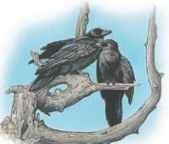
Preen…
Courtship continues in a dead tree, where the pair preens each other to reinforce their lifelong bond.
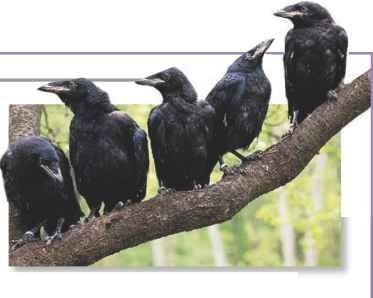
A Flower power The ruby-throat is attracted to nectar-rich blooms.
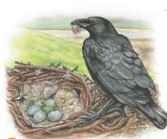
Build…
Both carry nest material to a rocky crag.The female adds a final touch to their nest: a snug hair lining.
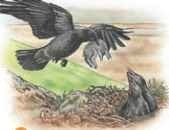
Feed
To satisfy their hungry chicks, both parents have to bring food, such as this baby hare.
BEHAVIOR
The raven is a master of the air, performing complex aerial maneuvers with grace — sometimes for no apparent reason other than the “enjoyment” of its own abilities. It circles, soars and nose-dives, and, in pairs or parties, often engages in tail-chasing dashes and “stunts,” such as half-closing its wings to make itself stall and tumble downward. It can even flip over and fly upside down for short distances.
Along with other members of the crow family, the raven is regarded as among the most intelligent of birds. There are records of it approaching its nest site by a hidden route to avoid giving away its location.
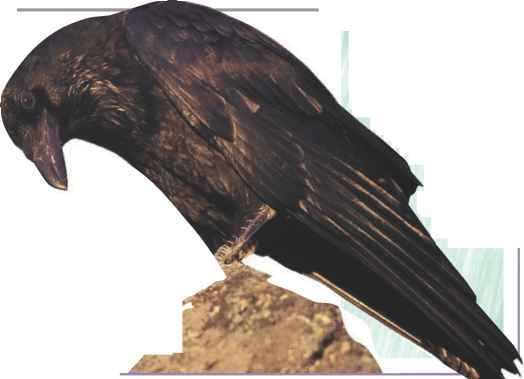
Quick thinker In captivity, the raven learns to mimic the human voice or perform “tricks” for food rewards, such as throwing coins with its bill. It’s also able to pass a variety of simple intelligence tests.
CONSERVATION
The raven has been driven from many lowland areas as a result of human persecution, usually by landowners or farmers, but is safe in the remote parts of its vast range.
PROFILE
Raven
As large as a red-billed hawk, the raven turns into a ruthlessly efficient hunter if its usual diet of carrion is in short supply.
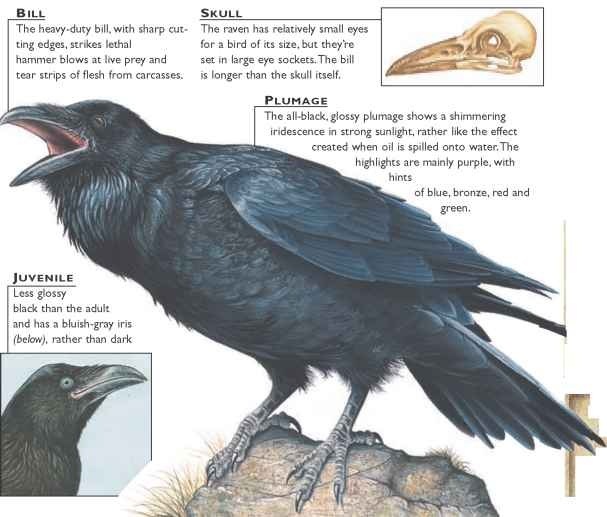
CREATURE COMPARISONS
At first sight, the raven, American crow (Corvus brachyrhynchos) and fish crow (C ossifragus) look alike: large, glossy-black birds with broad wings and long tails. But the latter birds are two-thirds the raven’s size.The raven’s head, wings and tail project further giving it a more elongated, cross-shaped silhouette.
Also note that the raven’s tail forms a point at the end; the American and fish crows’ are rounded.The American crow is found in woodlands and suburban areas; the fish crow prefers the coast and often lives in the cities.
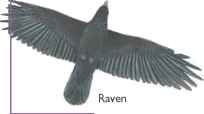
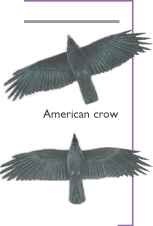
| VITAL Weight Length WINGSPAN |
STATISTICS 1-3 lbs. Up to V 4-5′ |
| Sexual Maturity | 2-6 years |
| Breeding Season | February -June |
| Number of Eggs | 2-7 (usually 4-6) |
| Incubation Period | 20-21 days |
| Fledging Period | 35-49 days |
| Breeding Interval | year |
| Typical Diet Lifespan |
Carrion and -scraps; also a range of live prey, birds’ eggs and seeds 13 years in wild 30 in captivity |
RELATED SPECIES
• Of the 115 crow species in the family Corvidae, 42 are “typical crows.” In the genus Corvus, these include the American, northwestern and fish crows, as well as 9 raven species. The remaining 73 species, split in 25 genera, include jays and the black-billed magpie (below).

Fish crow
